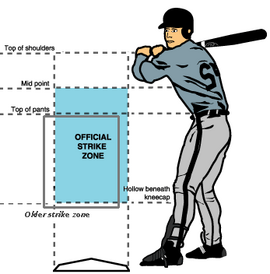
This is the first in a series of articles that will go through the mechanics and physics of different pitches. I will explain why each pitch is an important weapon in a pitcher’s arsenal, and how to effectively throw the pitch so you don’t hurt yourself, or hurt your team by getting rocked.
First off on our list is the most basic of pitches – the four seam fastball.
Four Seam Fastball Physics
The four seam fastball is designed to be the straightest, fastest pitch in your arsenal. The “four seam” grip is designed so that there is minimal movement either vertically or horizontally. A good four seam fastball will stay on the same plane from the pitcher’s hand to the catcher’s glove.

To completely understand the physics of the pitch, we must first look at how to grip the ball. As you can see, the pitcher’s hand is touching all four of the “seams” on the ball. Technically there is only one continuous seam on a baseball, but the way it horseshoes and circles around, provide the necessary contact points for a four seam pitch. The surrounding air “catches” these seams and depending on the rotation of the ball, dictate which direction the pitch will break. In the case of the four seam fastball, it is meant to be thrown with maximum backspin and no sidespin, meaning that the air will catch the ball and seemingly push it up. However, the short distance from mound to plate, as well as the gravity pushing down on the ball, means that the pitch simply stays straight.
Recap: Gravity is pushing the ball down, the backspin from the 4 seams pushes the ball back up, meaning that the pitch will stay straight.
Why is a Four Seam Fastball Important?
“If the four seam fastball doesn’t break in either direction, then how can it be effective?” you might ask. Its effectiveness does not lie in its ability to fool a hitter into swinging, instead it is meant to cross the plate for a strike before the batter can decide whether to swing or not. Aside from being the fastest pitch in a hurler’s selection, it is also the most accurate. You will see a lot of pitchers throw a four seam fastball on the first pitch just to “get ahead in the count.” Getting ahead in the count refers to a pitcher having the advantage with more strikes than balls. So in this case, starting the batter off with a strike gives the pitcher the advantage.
Pitchers also turn to the four seam fastball when they are behind in the count. From a pitcher’s perspective, behind in the count means that they have thrown more balls than strikes to the batter. Instead of increasing the likelihood of surrendering a walk to a hitter who has a 3 ball count, many pitchers try to get the advantage back by throwing a strike. More often than not, this is accomplished with a four seam fastball.
Setting up the Pitch

A pitcher cannot get by on just a four seam fastball alone. Because of it’s consistency in speed and eye path, batters will key in on the pitch as the game goes on and be able to hit it with much more ease. Knowing when to throw a four seam fastball can be just as important as knowing where to throw it. As you think about which pitch to throw next, think about how the batter handled the last pitch you threw. Did they swing late? Early? Right on time? If the batter swung late on your last pitch, it is a great time to throw the 4-seam fastball, ideally around chest high. It takes longer, usually microseconds (but that’s enough time) for a batter to get the bat in position for a high pitch. Thanks to the speed of the four seam fastball, if the batter was late on the previous pitch, he will be even later on the next pitch.
If the batter was early on your last pitch, you might want to stay away from the four seam fastball for a bit. Odds are they are trying to time your fastball and have obviously shown that you can’t get it by them. Try throwing a changeup or a breaking ball to keep the off balance.
If the batter was right on time, but fouled it straight back on the previous pitch, then you need to adjust your location a bit. Fastballs are best thrown inside. Why? Because the reaction time needed to get the bat head around on a ball inside is much faster than what is required to make contact with a ball on the outside part of the plate. It is always a good idea to mix up your location with the fastball (Up, Down, Away, Inside) but just know that a fastball inside is the most effective location for that pitch.
Recapping:
Although it is technically one of the more “boring” pitches in baseball, having a good fastball can take you far, as long as you mix up your locations. Unless you know a hitter’s weaknesses or tendencies, throwing a fastball in the same location every time can be dangerous. Stay tuned next week for our first off speed pitch of the series: The Changeup.
3 comments
Comments are closed.